Wulaia and the Missionaries – Part Four of a Tale of Exploration and Indians
Somewhat belatedly… the fourth in our series of articles about missionary encounters with the Yaghan.
If you haven’t been following along, check out the first, second, and third articles.
The final instalment will follow shortly!
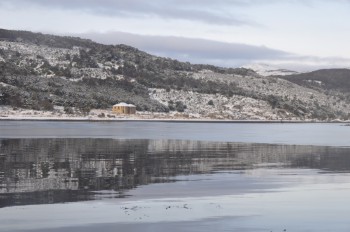
The days being short during the southern winter, by the time we reached Wulaia the sun was already low in the sky. We had planned to spend some time exploring the Yaghan ‘hut circles’, but as we approached the bay, wending our way amongst the islets and rocks, we realised that the whole place lay buried under a deep blanket of snow. Well, of course it did! Again, I found myself thinking how much nicer the scene would be in summer, and I pictured the natives sitting outside their wigwams in the sunshine. But – (how was it that I kept forgetting?) – there is no summer worthy of the name down here. The temperature can go up to 25°C, but it seldom gets above 10°C and snow is possible in any month.
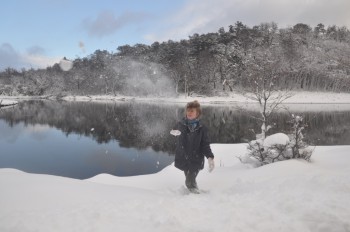
It’s odd that Fitzroy and Darwin make so little mention of snow. Magellan, by contrast, talks of blizzards and of icicles in the rigging; and some of his crew suffered frostbite. How in heaven’s name did the Yaghan survive in the snow? They were camping in the flimsiest of shelters – and they were in the nude! How is it possible? Throughout June, July, and August of this year there has been snow on the ground almost constantly. Throughout one particular week the temperature never rose above -14°C. If anything, the climate is probably warmer now than it was in the 1800s; so why didn’t the Yaghan all die of hypothermia?
Not only was the meadow at Wulaia carpeted with snow, as we drew near we realised that the bay was frozen right across. Gondwana‘s bow slammed into the ice, and as she punched her way through it, it broke apart. The noise was appalling; it was as if we were hammering our way through thick panes of glass.

After we’d anchored we still had to get ashore. That was even harder, because the sea-ice was not actually thick enough to support the weight of a man, and yet it was too thick to be broken with an oar. (It was about 2cm thick.) We eventually achieved our objective by using the weight of the dinghy to break a passage. Having reached the jetty we stepped onto the virgin snow. What a delicious moment! The familiar but totally unique creaking noise… The crisp clean prints left by our wellies…
But as I walked, I thought of the Yaghan. I pictured the print of a bare foot – and once again there arose that sense of disbelief. Surely, it isn’t possible to live naked in a climate like this?
When Fitzroy dumped his Yaghan protégées at this place there was no snow on the ground. It was January – the equivalent of June in the northern hemisphere – and the people were able to plant a vegetable garden. As we have seen, the garden never bore fruit (except for the rhubarb which, we hear, still flourishes here in season) and the young gentleman’s effort to bring Christian civilisation to the natives was a failure. However, other seeds had been sown, and there were people who believed that they would not die; there were people who thought that a convert such as Jemmy Button would be bound to keep the faith alive. Accordingly, they wanted to go to him and help him to spread the Word. Could they have known what was really going on in Jemmy’s mind and what he would do in a few years time, they would surely have kept well away from that man…
The first to take up the banner which Fitzroy had dropped was one Allen Gardiner. His story is filled with equal measures of glorious faith and utter pathos – the favourite ingredients for a Victorian saga. Essentially, he and his followers arrived in Tierra del Fuego equipped only with trust in their god. Gardiner hoped to make contact with Jemmy Button, but he was put ashore in the wrong place and he ended up being hounded by the people he’d come to save. Eventually, lacking the Yaghan’s ability to find food, the party all died of hunger. Their tale lives on purely because of the letters and diaries which they left behind, for these reveal the missionaries to have been men for whom martyrdom (and hypothermia, scurvy, and hunger) were an absolute delight. One of the party died having just penned the words, “I am happy beyond belief”. Gardiner himself also passed on in a state of religious ecstasy.
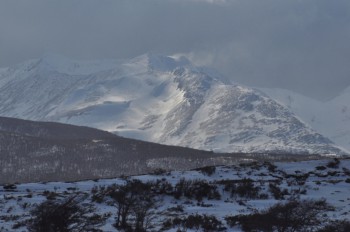
Besides telling the pathetic tale of his companions’ demise, Allen Gardiner’s diary also contained the outline for a new plan. Having met them, he now realised that the Yaghan were so primitive and so savage that it was not possible to establish a mission amongst them – so, he decided, he would set up a station in the Falkland Islands instead; and the natives would be rounded up and taken over there.
After Gardiner’s body was found and the story of his glorious death became known, his admirers rushed to put the plan into action. The principal actor in the next round of events was one George Despard. This gentleman was able to arrange the purchase of a small vessel, which was christened Allen Gardiner – an unfortunate choice, in my view – and he also secured the lease of Keppel Island (one of the outer Falklands). Together with his wife, their own children, and two adopted children, Despard hurried south. A base was established, and a year later the schooner was despatched to sail to Wulaia and find Jemmy Button.
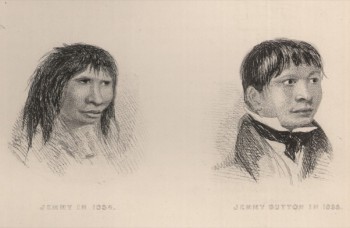
The year was now 1855. 21 years had passed since Jemmy Button had waved goodbye to Darwin and Fitzroy and to his other friends aboard the Beagle. In the intervening time he had lived, with his friends and family, in the traditional Yaghan manner. His days will have been devoted largely to hunting birds and seals with which to feed his growing brood, and to the making and mending of his small selection of weapons and tools: the flint scrapers; the bone harpoon lashed to a wooden pole; a sling-shot which was always to hand, being worn around his waist; and a bow and some arrows.
On days when the sea was calm, Jemmy and his companions put to sea in their bark canoes, and when his prey was sighted the hunter crouched with his harpoon in the bow. The paddling of the canoe was left to his wife, and his children were responsible for keeping alight the fire on which their lives all depended. Yaghan women seem to have been even tougher than their menfolk: When the hunting party returned to Wulaia, Jemmy’s wife will have dropped him off at the beach with the kids, and then she will have paddled away, anchored the boat to the kelp which grows abundantly all throughout this region, and then hopped overboard and swum ashore. Charles Darwin reported seeing a woman swim ashore through the icy water with a baby on her back, and anthropologists have said that it was the custom for a woman, on giving birth, to immediately wash both herself and her newborn in the sea. Perhaps it was his observation of this behaviour which prompted Darwin’s theory of the survival of the fittest.
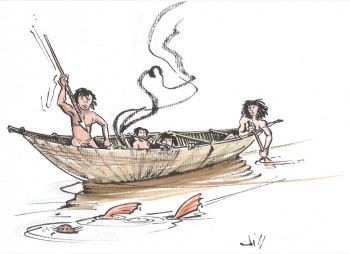 As the most able canoeists, the women were also the chief fisherfolk. Their tackle consisted of a seal-gut rope made from two sinews twisted together in the usual primitive manner. The rope was equipped with a noose to carry the bait, but it had no hook, hooks not having been invented by this people. Instead, when she felt the fish biting, the fisher would hoik it aboard swiftly and then bite off its head to kill it. Fish were also caught in a man-made rock-pool which can still be seen to the south of the village. Having become embayed in here they were speared.
As the most able canoeists, the women were also the chief fisherfolk. Their tackle consisted of a seal-gut rope made from two sinews twisted together in the usual primitive manner. The rope was equipped with a noose to carry the bait, but it had no hook, hooks not having been invented by this people. Instead, when she felt the fish biting, the fisher would hoik it aboard swiftly and then bite off its head to kill it. Fish were also caught in a man-made rock-pool which can still be seen to the south of the village. Having become embayed in here they were speared.
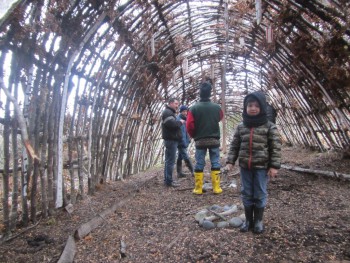
During the long days of summer the sun will sometimes have been warm enough for Jemmy Button and his friends to move away from their fires. But during the winter the snow will sometimes have been deep enough to make finding fuel for those fires very difficult, and it will also have made it hard for them to hunt. At times, when the snow lay thick and the bay was covered in ice, the people’s only source of food will have been the giant mussels which the womenfolk gathered on the shore at low tide. This staple was roasted in the fire, and its consumption gave rise to the most visible sign of the Yaghan’s one-time presence in this land. The fire was placed in a pit in the centre of the family’s dome-shaped wigwam, and the empty mussel shells and any other waste were piled up outside. Over the course of several decades the waste formed a low wall around each hut, and these circles, or conchales, are to be found all around the coast of Isla Navarino and especially at Wulaia. In some cases the circles are so big that one wonders whether the people might have been throwing their shells and seal-bones outside their wigwams for centuries. But, as I say, on the occasion of our visit the snow hid all trace of archaeological remains, and we could only gaze across the white meadowland and imagine… Most of all, I found myself imagining the feelings of Jemmy Button when one of his kids came running up to bring him the news: “Dad! There’s a huge canoe coming!”
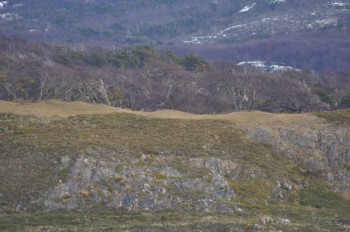
So carried away were the Europeans with their own endeavour that it never occurred to them that Jemmy Button might not have kept the faith. When this semi-mythological figure arrived before them naked and with matted hair they were astonished. They recognised him only through the fact that he could speak a garbled sort of English. What did they expect? That the man would still be wearing the same clothes that he had been left with, 21 years earlier?
Still, Jemmy did remember the customs of the people who had once taken him to visit their land, and on seeing that there was a woman aboard the schooner he asked to borrow a pair of trousers.
Seemingly, Jemmy was delighted to meet his visitors, but when they asked him to come with him to Keppel Island he refused. He did try to persuade some of his friends to go there, but there were no takers; so, back the ship went, empty-handed. It was all a bit of an anti-climax.
Despite this less than promising start, the missionary society persisted – as missionary societies invariably do – and on the second visit to Wulaia some of the Yaghan were induced to move to the Falklands and learn the European lifestyle. Amongst these adventurous souls there were a number of children – indeed, the do-gooders appear to have made a habit of befriending orphaned or abandoned infants – and when these children encountered Despard’s kids and played with them, each began to learn the other’s lingo. In this matter no child was more proficient than the adopted boy, Thomas Bridges. Young Bridges soon became a useful interpreter, and perhaps it was for this reason that he was obliged to remain behind at Keppel Island when the missionaries eventually embarked upon stage two of Gardiner’s plan: the establishment of a base in Tierra del Fuego.
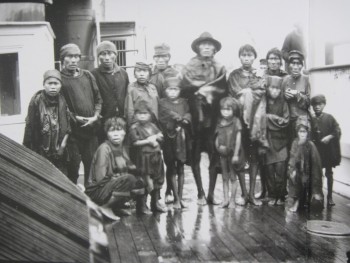
Four more years had passed, and the Patagonian Missionary Society believed that relations with the Yaghan were now very amicable. Three families had been acclimatised to the Victorian way of life and to the white man’s beliefs and rules, and the time had now come to return them to their homeland. Here they would spread the Good Word, improve the morals of their compatriots, and introduce such concepts as gardening, prudishness, the use of soap, and obedience to a higher authority.
And so the missionaries set out again, with joy in their hearts and their protégées in tow. If you want to know how they got on this time, pop back next week for the final instalment of the saga.
